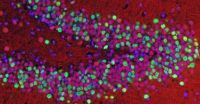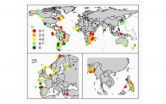New method for making large quantities of deuterium-depleted drinking water
2011-01-06
(Press-News.org) Scientists in China are reporting development of a less expensive, more eco-friendly method for making deuterium-depleted drinking water, citing studies suggesting that it may be a more healthful form of water. Their report appears in ACS' bi-weekly journal Industrial & Engineering Chemistry Research.
Changgong Meng and Feng Huang note that natural water, widely known as H2O, actually is a mixture of H2O and tiny amounts of D2O — about 150 parts per million (ppm), or a few drops of D2O in every quart of water. Deuterium-depleted water usually contains about 125 ppm. The "D" is deuterium, an isotope or variant form of hydrogen often termed "heavy hydrogen." They cite accumulating evidence that water with high levels of deuterium may have adverse health effects on animals and plants, while deuterium-depleted water may be useful in treatment of certain diseases. Existing ways of removing deuterium from water tend to be expensive, inefficient, or environmentally harmful.
They describe a new method that helps overcome these problems, and could be the basis for the first industrial-scale production of deuterium-depleted water. It involves a platinum catalyst that quickly and efficiently removes deuterium from water using a combination of cold and hot temperatures. In laboratory-scale tests, the new technique reduced the amount of deuterium in water from about 145 parts per million to 125 parts per million. The resulting water is suitable for drinking, the scientists say, and could be produced in large quantities at economical cost.
INFORMATION:ARTICLE FOR IMMEDIATE RELEASE
"Method for the Production of Deuterium-Depleted Potable Water"
DOWNLOAD FULL TEXT ARTICLE
http://pubs.acs.org/stoken/presspac/presspac/full/10.1021/ie101820f
CONTACT:
Changgong Meng, Ph.D.
Department of Chemistry
Dalian University of Technology
Dalian, China
Phone: 86-411-84708545
Fax: 86-411-84708545
Email: cgmeng@dlut.edu.cn
END
ELSE PRESS RELEASES FROM THIS DATE:
2011-01-06
A team of researchers at Mount Sinai School of Medicine has developed the first web-based screening tool for Traumatic Brain Injury (TBI). This instrument has recently been used by soldiers returning from the wars in Iraq and Afghanistan who participated in the Sixth Annual Road to Recovery Conference and Tribute in Orlando to determine if they sustained a TBI.
"Traumatic brain injury is underdiagnosed, and left untreated can have long-term cognitive, behavioral and physical effects," said Wayne Gordon, PhD, the Jack Nash Professor of Rehabilitation Medicine and an Associate ...
2011-01-06
Scientists are reporting new evidence on how studded tires — wintertime fixtures in some areas but banned in others for causing damage to pavement — may also damage the health of motorists and people living near highways. Studded tires have small metal protrusions from the rubber tread that improve traction on icy or snow-covered roads. Their study appears in ACS' Chemical Research in Toxicology, a monthly journal.
Anders Ljungman and colleagues note that studded tires grind away at the road surface, generating the kind of dust particles believed to contribute to heart ...
2011-01-06
Momentum is building for a new energy "smart grid" that would overhaul the U.S.'s 100-year-old electrical power network. The impact would be huge –– from installation of a new web of electrical transmission lines to smart meters to control home appliances. The meters would offer consumers discounted rates if they use electricity at off-peak hours. A key objective of the $1.5 trillion dollar plan is "time of use" electricity pricing that would increase the cost to consumers of energy at peak mid-day hours and lower it at others, according to an article in the current edition ...
2011-01-06
Alexandria, VA – Over the past five decades, OPEC has earned a reputation for being a powerful cartel that controls the world's oil production and prices - but there are limits to OPEC's influence and wealth. In fact, many OPEC countries face grave problems, which are to some extent the result of their oil-income dependence. EARTH examines OPEC's past, current and future place in this world. Will OPEC continue to control the planet's oil for the next 50 years?
Learn more about this eye-opening subject in February's featured article "OPEC and Oil: The Next 50 Years," and ...
2011-01-06
Dr. Emil Kozarov and a team of researchers at the Columbia University College of Dental Medicine have identified specific bacteria that may have a key role in vascular pathogenesis, specifically atherosclerosis, or what is commonly referred to as "hardening of the arteries" – the number one cause of death in the United States.
Fully understanding the role of infections in cardiovascular diseases has been challenging because researchers have previously been unable to isolate live bacteria from atherosclerotic tissue. Using tissue specimens from the Department of Surgery ...
2011-01-06
PHILADELPHIA – Lou Gehrig's disease, or amyotrophic lateral sclerosis (ALS), and frontotemporal lobar degeneration (FTLD) are characterized by protein clumps in brain and spinal-cord cells that include an RNA-binding protein called TDP-43. This protein is the major building block of the lesions formed by these clumps.
In a study published in the Journal of Clinical Investigation, a team led by Virginia M.-Y. Lee, PhD, director of Penn's Center for Neurodegenerative Disease Research, describes the first direct evidence of how mutated TDP-43 can cause neurons to die. Although ...
2011-01-06
A team led by Patrick T. Mather, director of Syracuse Biomaterials Institute (SBI) and Milton and Ann Stevenson professor of biomedical and chemical engineering in Syracuse University's L.C. Smith College of Engineering and Computer Science (LCS), has succeeded in applying the concept of functionally graded materials (FGMs) to shape memory polymers (SMPs).
SMPs are a class of "smart" materials that can switch between two shapes, from a fixed (temporary) shape to a predetermined permanent shape. Shape memory polymers function as actuators, by first forming a heated article ...
2011-01-06
The oceans became oxygen-rich as they are today about 600 million years ago, during Earth's Late Ediacaran Period. Before that, most scientists believed until recently, the ancient oceans were relatively oxygen-poor for the preceding four billion years.
Now biogeochemists at the University of California-Riverside (UCR) have found evidence that the oceans went back to being "anoxic," or oxygen-poor, around 499 million years ago, soon after the first appearance of animals on the planet.
They remained anoxic for two to four million years.
The researchers suggest that ...
2011-01-06
CHAMPAIGN, Ill. — In one University of Illinois lab, invisibility is a matter of now you hear it, now you don't.
Led by mechanical science and engineering professor Nicholas Fang, Illinois researchers have demonstrated an acoustic cloak, a technology that renders underwater objects invisible to sonar and other ultrasound waves.
"We are not talking about science fiction. We are talking about controlling sound waves by bending and twisting them in a designer space," said Fang, who also is affiliated with the Beckman Institute for Advanced Science and Technology. "This ...
2011-01-06
The bulk of the world's fisheries--including the kind of small-scale, often non-industrialized fisheries that millions of people depend on for food--could be sustained using community-based co-management. This is the conclusion of a study reported in this week's issue of the journal Nature.
"The majority of the world's fisheries are not--and never will be--managed by strong centralized governments with top-down rules and the means to enforce them," says Nicolas Gutiérrez, a University of Washington fisheries scientist and lead author of the Nature paper.
"Our findings ...
LAST 30 PRESS RELEASES:
[Press-News.org] New method for making large quantities of deuterium-depleted drinking water



